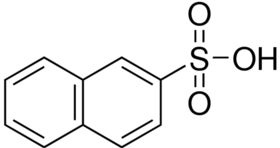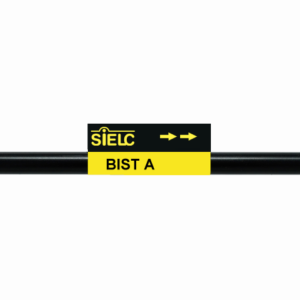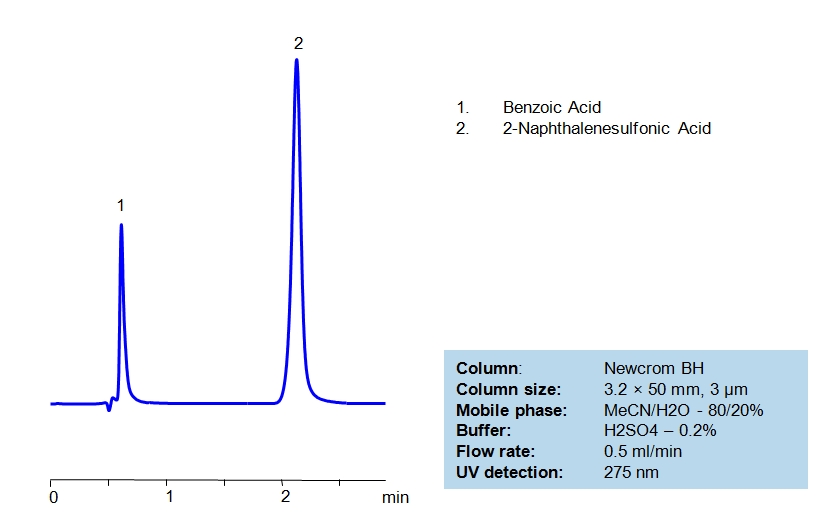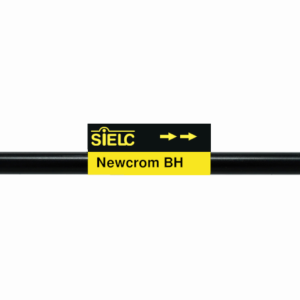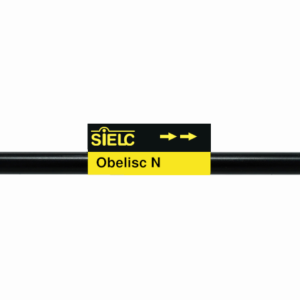| CAS Number | 120-18-3 |
|---|---|
| Molecular Formula | C10H8O3S |
| Molecular Weight | 208.24 |
| InChI Key | KVBGVZZKJNLNJU-UHFFFAOYSA-N |
| LogP | -0.4 |
| Synonyms |
|
Applications:
HPLC Method for Analysis of 2 – Naphthalenesulfonic acid and 1,5 -Naphthalenedisulfonic acid on BIST A Column
December 1, 2022
HPLC Method for Analysis of 2-Naphthalenesulfonic Acid, 1,5-Naphthalenedisulfonic Acid on BIST A Column by SIELC Technologies
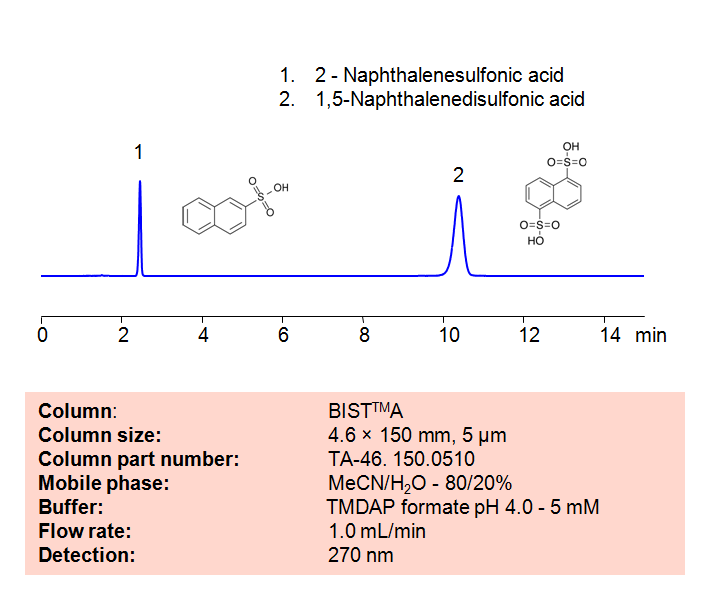
2-Naphthalenesulfonic acid and 1,5-Naphthalenedisulfonic acid, also known as Armstrong’s acid, are two similarly-structured compounds. 2-Naphthalenesulfonic acid is commonly used in dye production and 1,5-Naphthalenedisulfonic acid is used in synthesizing the salts of basic drugs and in electrokinetic chromatography.
2-Naphthalenesulfonic Acid is an organic compound with the formula C10H7SO3H. It is used primarily in the production of dyes, but has also historically been industrially used for a it’s various chemical reactions.
1,5-Naphthalenedisulfonic acid is a strong organic acid with a double charge. It has the chemical formula C10H8S2O6.
Using SIELC’s newly introduced BIST™ method, these two acids can be retained on a negatively-charged, cation-exchange BIST A. There are two keys to this retention method: 1) a multi-charged, positive buffer, such as N,N,N’,N’-Tetramethyl-1,3-propanediamine (TMDAP), which acts as a bridge, linking the negatively-charged tartrazine analytes to the negatively-charged column surface and 2) a mobile phase consisting mostly of organic solvent to minimize the formation of a solvation layer around the charged analytes. Using this new and unique analysis method, 2-Naphthalenesulfonic acid and 1,5-Naphthalenedisulfonic acid can be retained and UV detected at 270 nm.
Condition
| Column | BIST A, 4.6 x 150 mm, 5 µm, 100 A, dual ended |
| Mobile Phase | MeCN – 80/20% |
| Buffer | TMDAP formate pH 4.0 – 5,0 mM |
| Flow Rate | 1.0 ml/min |
| Detection | 270 nm |
Description
| Class of Compounds | Acid, Sulfonic acid |
| Analyzing Compounds | 2-Naphthalenesulfonic Acid, 1,5-Naphthalenedisulfonic Acid |
Application Column
BIST A
Column Diameter: 4.6 mm
Column Length: 150 mm
Particle Size: 5 µm
Pore Size: 100 A
Column options: dual ended
2-Naphthalenesulfonic Acid

HPLC Separation of Benzoic and 2-naphtalenesulfonic Acids
June 9, 2020
HPLC Method for Benzoic Acid, 2-Naphthalenesulfonic Acid on Newcrom BH by SIELC Technologies
High Performance Liquid Chromatography (HPLC) Method for Analysis of Benzoic Acid, 2-Naphthalenesulfonic Acid.
Benzoic Acid is an organic acid with antimicrobial properties. It is typically used in cosmetics, food, and pharmaceuticals as a preservative against yeast and mold. As treatment, it is also used as a topical medicine of fungal skin infections. It can be naturally found in many berries and vegetable resins. With it’s chemical formula being C7H6O2, it is considered the simplest aromatic carboxylic acid. You can find detailed UV spectra of Benzoic Acid and information about its various lambda maxima by visiting the following link.
2-Naphthalenesulfonic Acid is an organic compound with the formula C10H7SO3H. It is used primarily in the production of dyes, but has also historically been industrially used for a it’s various chemical reactions.
Newcrom BH column is used for HPLC separation of weak and strong organic acids using a mixed-mode method. Benzoic and naphthalenesulfonic acids are retained based on polar interaction mode and anion-exchange mode. The isocratic separation is achieved very quickly on a short 3.2 x 50 mm column in under 3 minutes. The mobile phase is acetonitrile (ACN) and water with sulfuric acid buffer. UV detection at 275nm.
| Column | Newcrom BH, 3.2 x 50 mm, 3 µm, 100 A, dual ended |
| Mobile Phase | MeCN/H2O – 80/20% |
| Buffer | H2SO4 – 0.2% |
| Flow Rate | 0.5 ml/min |
| Detection | UV 275nm |
| Class of Compounds | Acid |
| Analyzing Compounds | Benzoic Acid, 2-Naphthalenesulfonic Acid |
Application Column
Newcrom BH
Column Diameter: 3.2 mm
Column Length: 50 mm
Particle Size: 3 µm
Pore Size: 100 A
Column options: dual ended
Benzoic Acid

HILIC Separation of Aromatic Acids
August 22, 2008
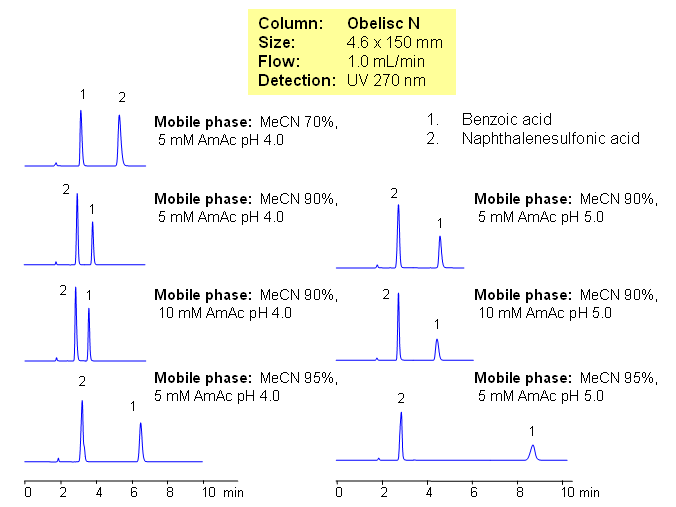
Obelisc N column are used for separation of weak and strong organic acids in mixed-mode HILIC. Benzoic and naphthalenesulfonic acids are retained based on polar interaction mode and anion-exchange mode. Order of elution and retention pattern can be changed by modifying mobile phase. PH of the mobile phase changes ionization state of stationary phase and analytes. Fast quantitation method for benzoic and naphthalenesulfonic acid can be developed using UV, ELSD or LC/MS detection. HPLC Method can be used for mixture of organic and inorganic strong and weak acids.
| Column | Obelisc N, 4.6×150 mm, 5 µm, 100A |
| Mobile Phase | MeCN/H2O |
| Buffer | AmAc |
| Flow Rate | 1.0 ml/min |
| Detection | UV, 270 nm |
| Class of Compounds |
Acid, Hydrophilic, Ionizable |
| Analyzing Compounds | Benzoic acid, Naphthalenesulfonic Acid |
Application Column
Obelisc N
SIELC has developed the Obelisc™ columns, which are mixed-mode and utilize Liquid Separation Cell technology (LiSC™). These cost-effective columns are the first of their kind to be commercially available and can replace multiple HPLC columns, including reversed-phase (RP), AQ-type reversed-phase, polar-embedded group RP columns, normal-phase, cation-exchange, anion-exchange, ion-exclusion, and HILIC (Hydrophilic Interaction Liquid Chromatography) columns. By controlling just three orthogonal method parameters - buffer concentration, buffer pH, and organic modifier concentration - users can adjust the column properties with pinpoint precision to separate complex mixtures.
Select optionsBenzoic Acid
Organic Acids

